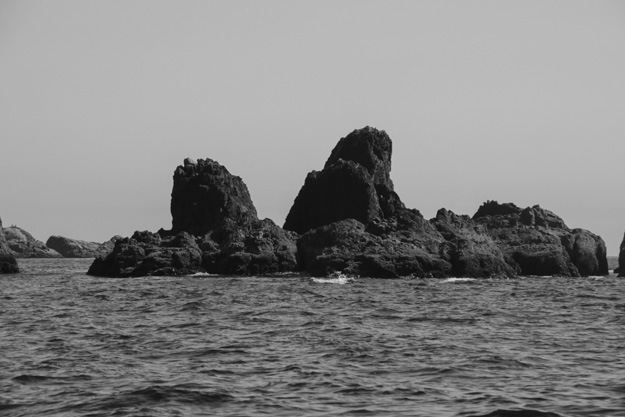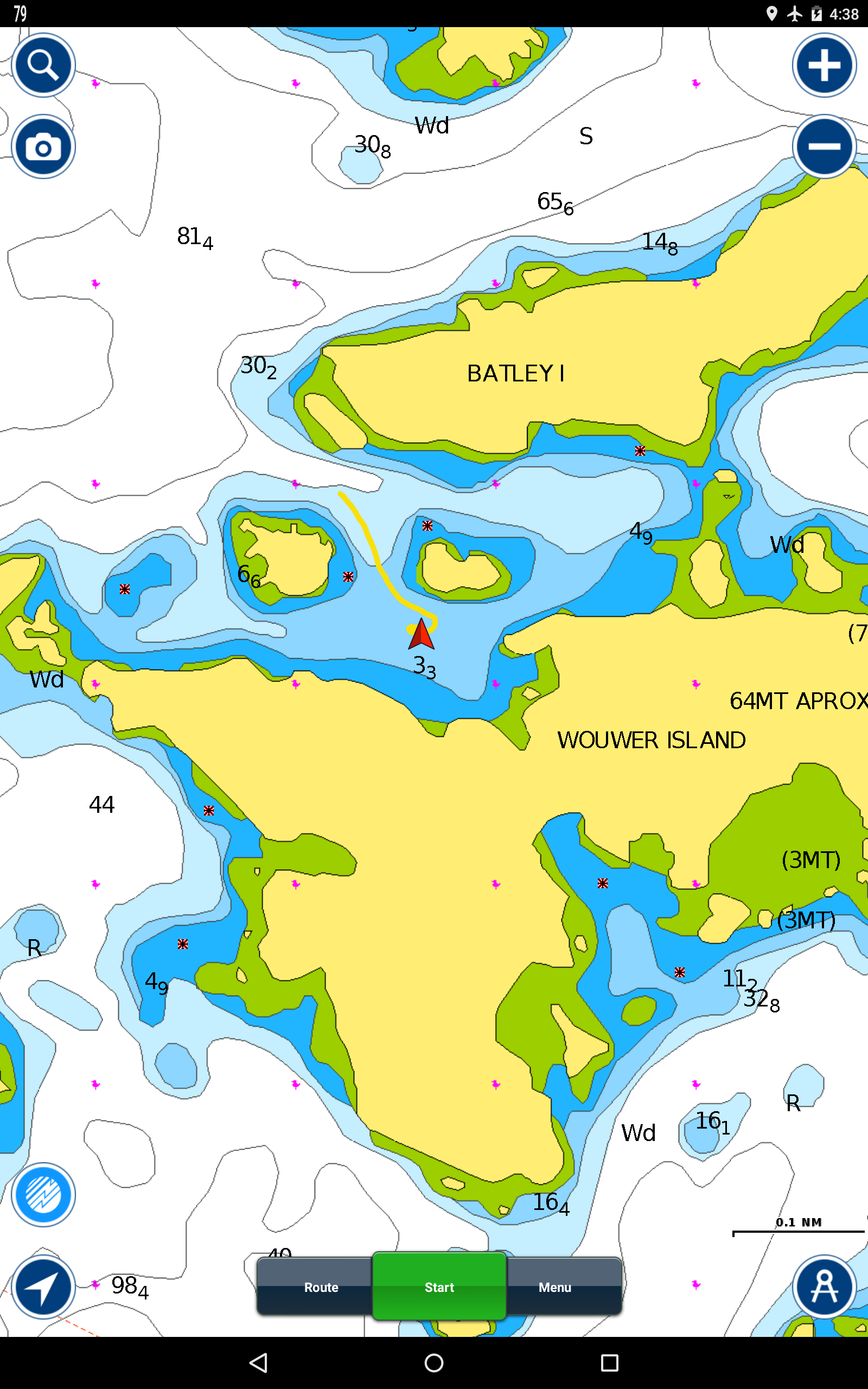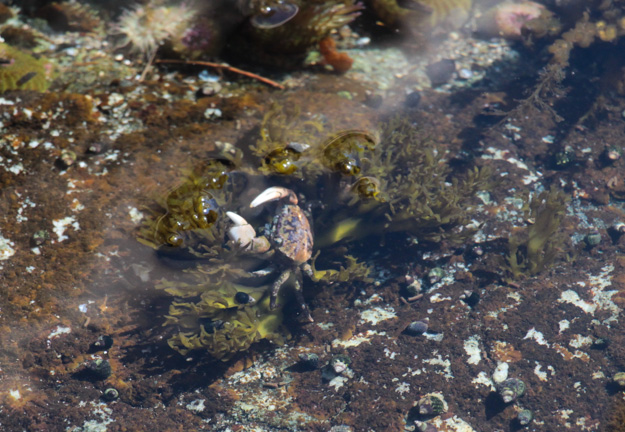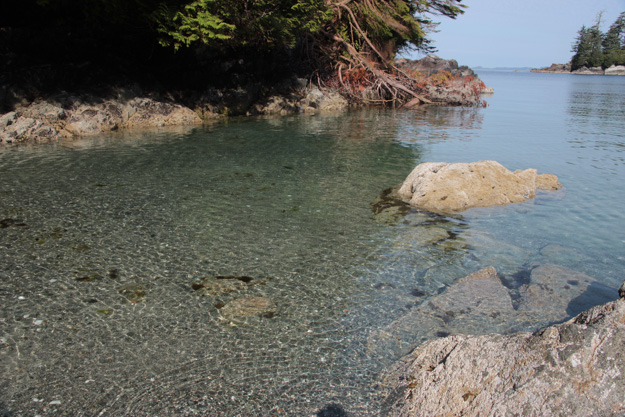After losing an extra day in Tofino due to the mouse that snuck aboard in the 4th St marina, we were eager to depart. A heavy morning fog was present out on the ocean though, so we waited till 10:30 for that to clear (plus there was no wind yet). We ended up having to motor all the way to Amphitheater Point outside Ucluelet – about 4 hours – but were able to sail with 8-10 kts that showed up in Barkley Sound. We’ve been finding the wind has been arriving later and is more short-lived in late July than it was the first half of July. Previously good wind started at 11am or noon, but now doesn’t start till 4 or 5pm.
This has made me wonder whether our July west coast cruise is perfectly mistimed by about 2 weeks. It would be better to start mid June when there’s still a chance of southerlies, and then return south in the 2nd week of July, when we had strong, consistent northerlies. Summer seems to have come early this year, and the last 2 weeks of July are resembling August weather – fog and low wind.
Still, sailing into Barkley Sound was fun, and I was reminded again of how spectacular Barkley Sound is – the sailing is always good there (at least all 7 days we were there during the month) and there are dozens of beautiful anchorages, many of them with no boats in them. We easily could’ve spent the whole month just cruising Barkley Sound, and I kind of wondered whether we should’ve done exactly that.
[This post took place from July 18 – 21]


Rocks outside of Wouwer Island
Wouwer Island
Wouwer Island is on the outside of the Broken Group, and is a really beautiful anchorage – surrounded by rocks, islands, trees, views of mountains and crystal clear water in the anchorage. Most guide books say it’s for settled conditions only, and I’d agree if there’s more than 20 knots it wouldn’t be comfy. The winds were about 15 after we arrived, and we had some wavelets and slight rocking. Not bad, but certainly not as calm as some other Barkley Sound anchorages.

There’s plenty of room in here for one boat, but two would be tricky without stern ties.




The next day, we had planned to go to Dodger Channel, spending one more night in Barkley Sound, but the weather forecast was calling for a rain front tomorrow (with either no wind or light opposing winds, which would mean little sailing on the ~30 nm trip to Port Renfrew), so we decided to go for Port Renfrew today instead, while there were still NW winds forecast.
The wind has been showing up late recently though – not until 4 or 5pm sometimes – so we ended up motoring from 10-1pm, then sailed with the spinnaker in 7-9 kts before motoring again when the wind disappeared, and then sailing again under spinnaker after 5pm when it gradually picked up to 15 kts.


Port Renfrew, Wood’s Nose nook
After an awesome spinnaker run into Port Renfrew, we decided to give Wood’s Nose a try. It’s a tiny nook on the eastern shore about 2 miles in that we had read about in “Exploring Vancouver Island’s West Coast” by Don Douglass. I was skeptical because it’s pretty small, and at Port Renfrew it’s critical to get out of the swell if you don’t want a rolly night.
Wood’s Nose ended up being great – the “nose” blocks the wind (15 kts out in the bay was only 2-4 in the nook) and swell was blocked by the rocky spit. It’s also a much more scenic place than our typical behind-the-marina-breakwater spot at the head of Port Renfrew, with a peak-a-boo view of the Strait, a small beach, and eagles in the trees dripping with old man’s beard (lichen).

We scoped out the dark blue section a little to determine depths, and found the edge would be 7 ft at the 2 ft low tide so we didn’t have to worry about going into that section a bit. There’s a kelp farm extending from the Wood’s Nose point.
It is a tricky anchorage, and only one large boat can easily fit in between the spit and the two fishing boat docks, but if you’re confident in being able to set your anchor in the middle and are comfortable with short scopes (we did 2.8:1), it’s quite possibly the best anchorage on the Canadian side of the Strait.

The “wood’s nose”



Port Renfrew to Becher Bay
Thursday we left about 10am after the night’s heavy rains had stopped, and had to motor until 2pm since there was no wind on the strait yet (and completely flat seas). This was frustrating for me since sailing downwind in the Strait was something I’d really been looking forward to, and the central strait usually has good wind.

Fog on the Strait, ahead of us
Fortunately about 2pm the wind showed up at 7-8 kts around Sheringham Point and later built to 15-20 around Sooke. We also had the flood current with us the whole way, so we set the spinnaker and ended up doing the 40 nautical miles in only 6 hours.

It’s not often you can sail with the spinnaker in the Strait of Juan de Fuca with your cold brew coffee easily resting on the deck!

Flying the Spinnaker Wing and Wing
I’ve written before about how much we love sailing wing and wing with the genoa and main, but we’d never tried doing this with the asymmetrical spinnaker. One of the frustrations of an asym is we generally can’t sail deeper than 150 degrees, and in light wind below 12 kts (when we usually need a spinnaker), we have to stay in the 120-140 degree range. This results in pretty slow progress towards the dead downwind destination. There are really only two points of sail we have in the straits and channels of the PNW – close hauled, and dead downwind – so we need to be able to go faster dead downwind (which happens to be our boat’s slowest point of sail).
We gave it a try wing and wing with the spinnaker and it worked beautifully. It allowed pointing at 180, more towards our destination, and gave us that wonderful balanced helm and level boat feeling of typical genoa-main wing and wing. I’m sure we’re not the first to think of this idea, but in eight years of cruising I’ve never seen another boat run an asym kite wing and wing. Certainly I’ve seen boats run only a spinnaker with no main, but not asym and main on opposite sides. So we weren’t sure whether it would really work.

We put the preventer on the main and jibed it to the opposing side. You then have to sheet out the spinnaker liberally, to allow the clew to rise and move forward. And it’s a delicate balancing act at the helm to keep the spinnaker from backwinding or collapsing – keeping a close eye on the leech for any flutter or folding. But once you get the hang of it it’s a lot of fun, and we sailed this way for about an hour, doing 5-5.5 kts in up to 15 kts of wind. Later we jibed the spinnaker so our main and spinnaker were on the same side and the wind built to 15-20 – we flew along at 6.5 knots, 8 kts over ground with the current push.
We’ve been getting better with the spinnaker – previously we had something go wrong pretty much every time we used it, but now we’ve got it down pretty well, and can fly it in higher winds than we previously would’ve considered.
Becher Bay
We anchored in the Murder Bay portion of Becher Bay this time, sailing onto anchor again (it’s surprisingly easy to do in Becher Bay, because there are no other boats anchored here, and the wind dies just as you get into the anchoring spot). I’m always surprised there are few boats here other than the fishing boats on the docks. It’s a beautiful anchorage, with Madrona trees along the shore, a view of the Strait, and ideal depths (6-12 ft).
At night though, we did discover Murder Bay must get its name from what your crew wants to do when you get waked by a container ship in the Strait. We had 30 minutes of heavy rolling at 2am, bottles sliding off counters and dishes clanking around in cabinets.
Becher Bay also has an awesome large park with many hiking trails in it. The park runs around the entirety of Bechey Head and has miles of forested trails. We only had time for the walk to the petroglyphs though. We docked our dinghy at the fishing vessels dock but later realized it’s not a public dock and we probably shouldn’t have gone there – next time we’d beach our dinghy directly at the park area south of there. The trail runs along the beach.

Hiking trails to the west of Becher Bay. We only did a small fraction of them!

Petroglyph (an ancient First Nations painting) on the rocks – this one they say is a seal.
Coming Up
We’re taking a rest day in Becher Bay and then heading to Victoria to do some crew switching – Natalie has to head back to work and her dad is taking the Clipper up to help me out.

Thanks for the Wood’s Nose info – I’ll have to try it out!